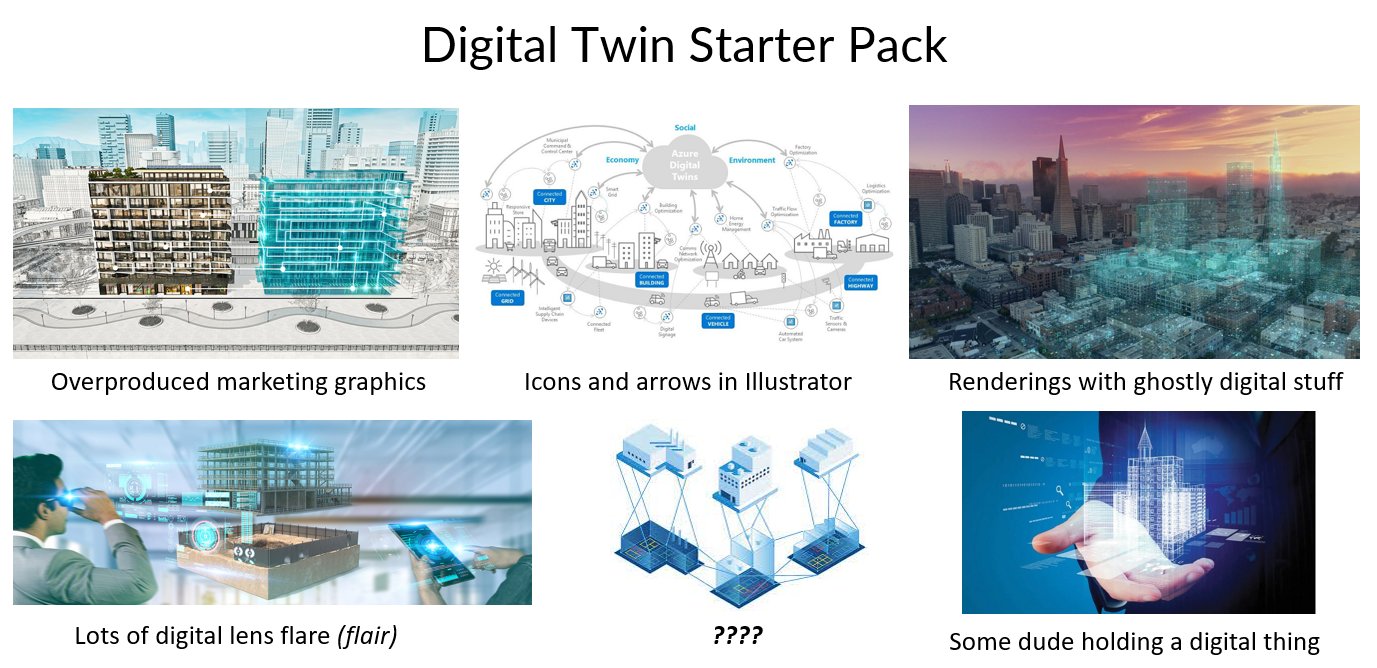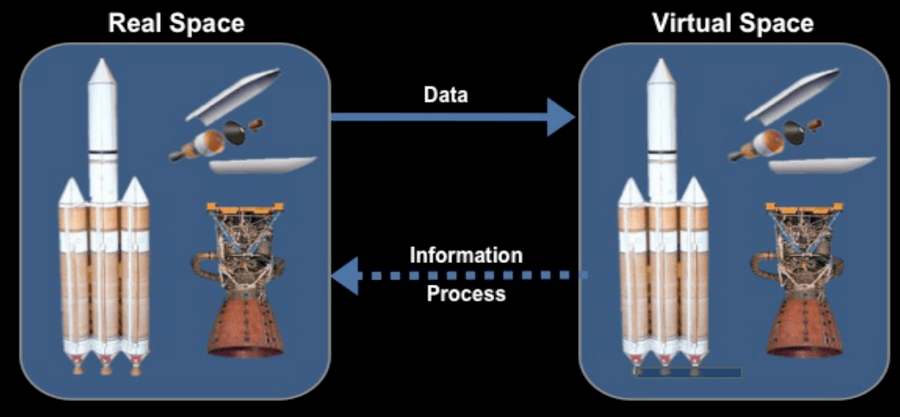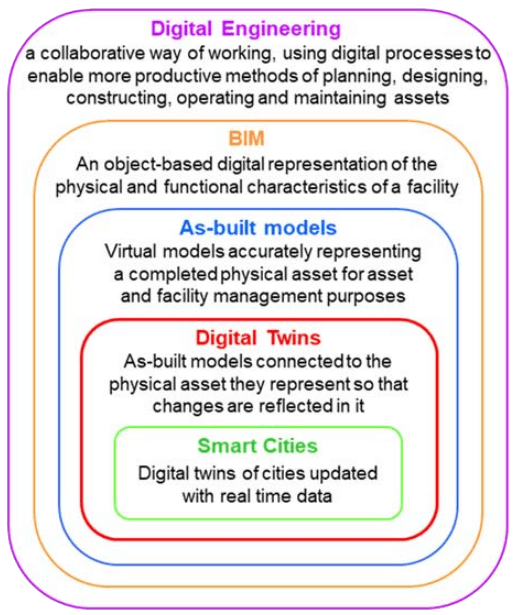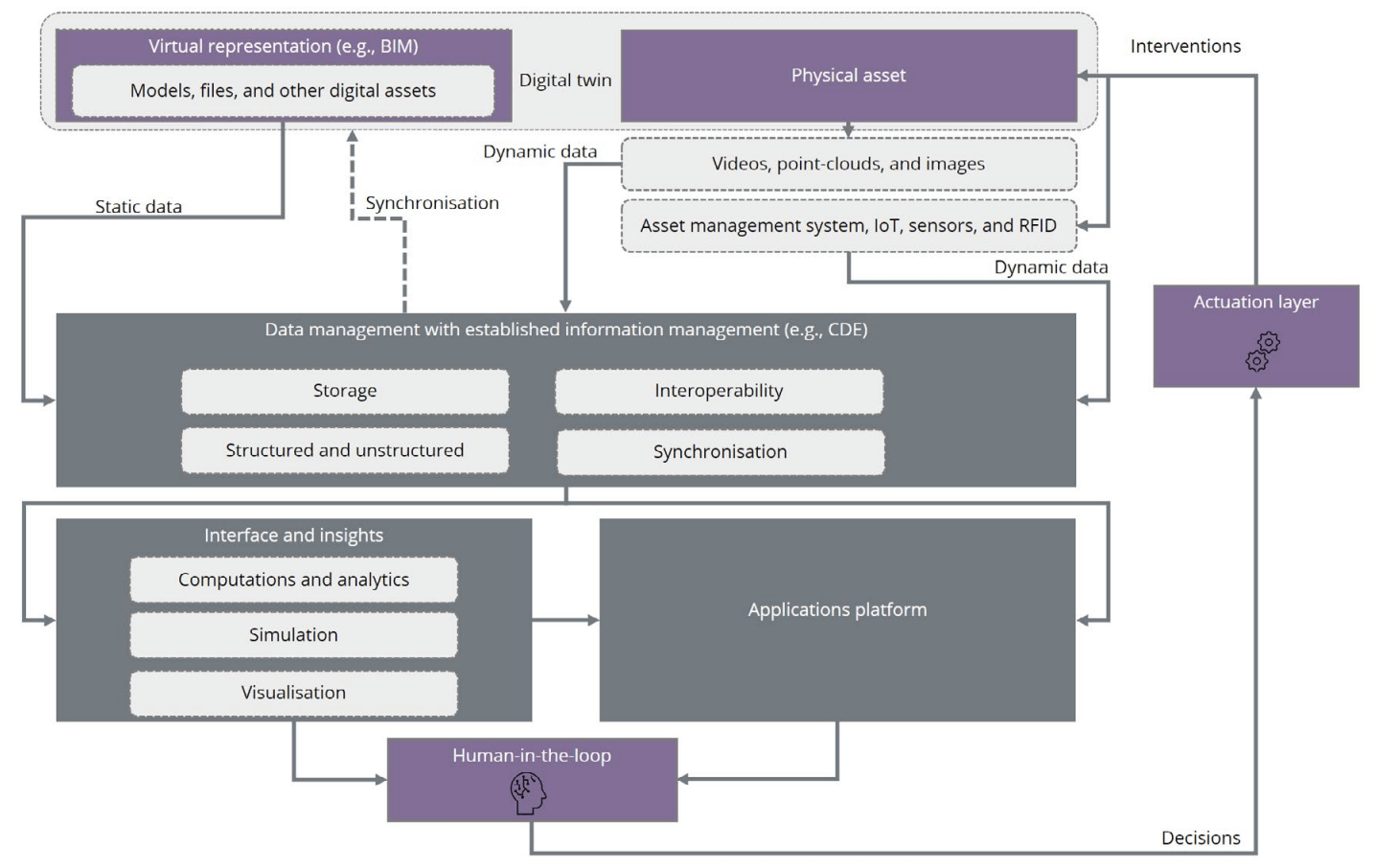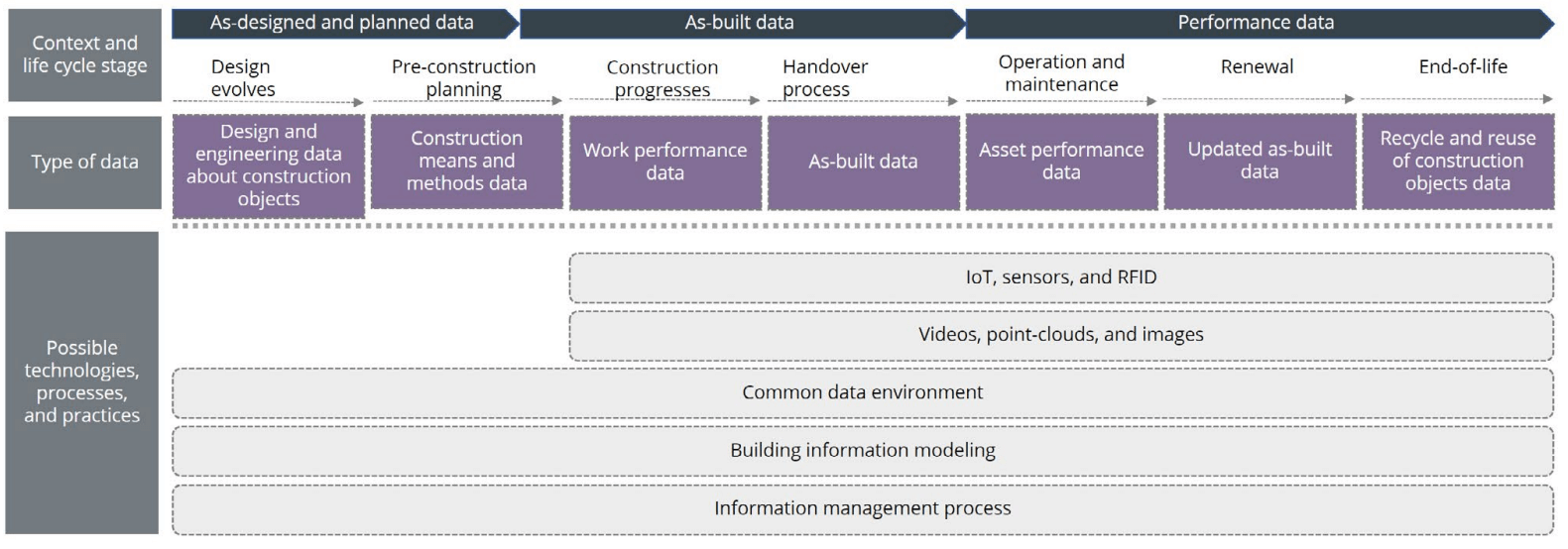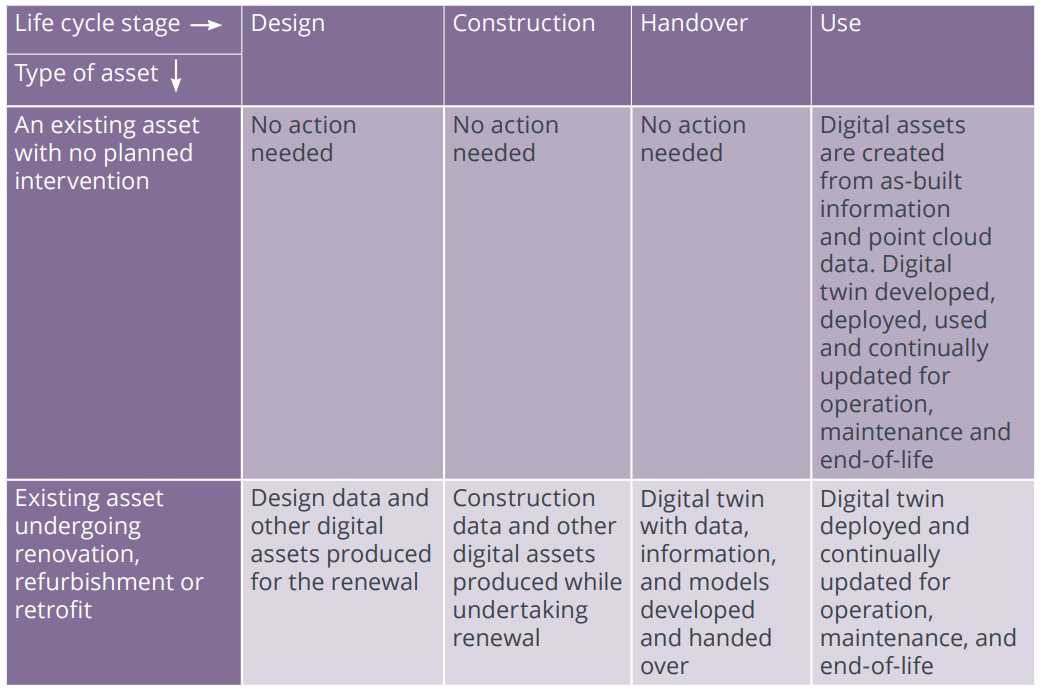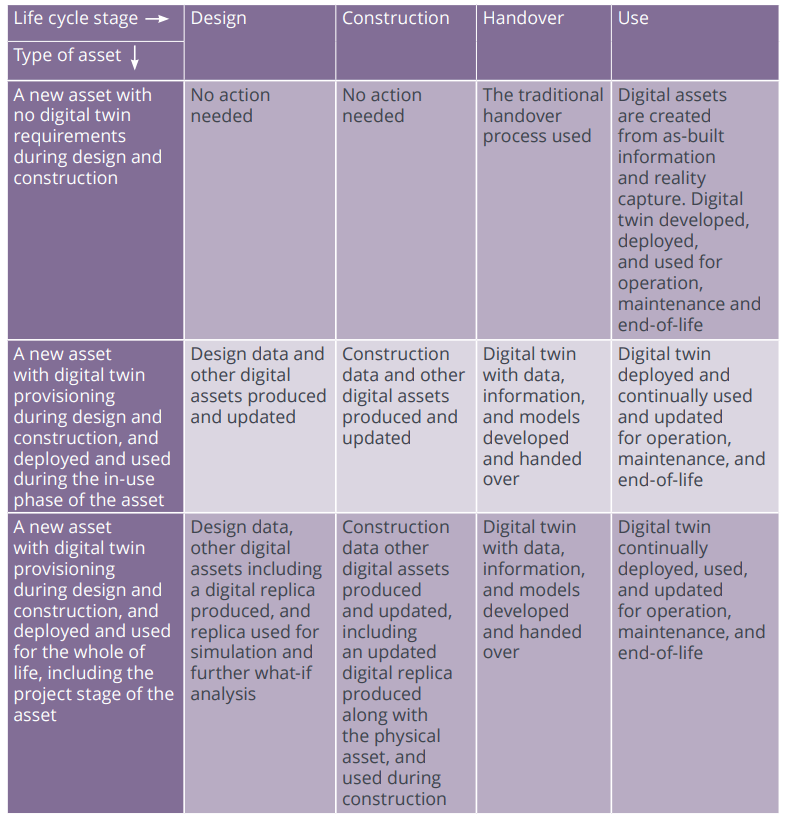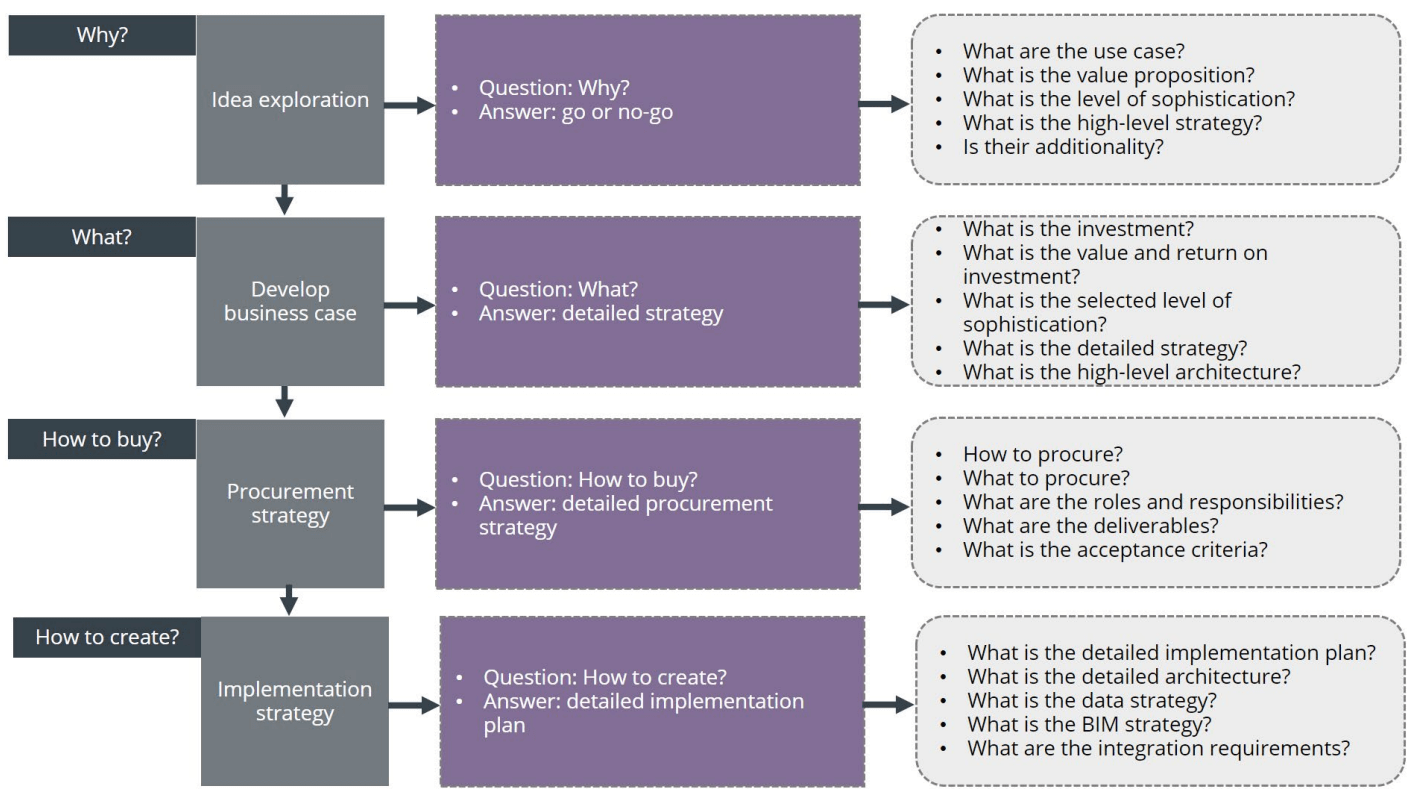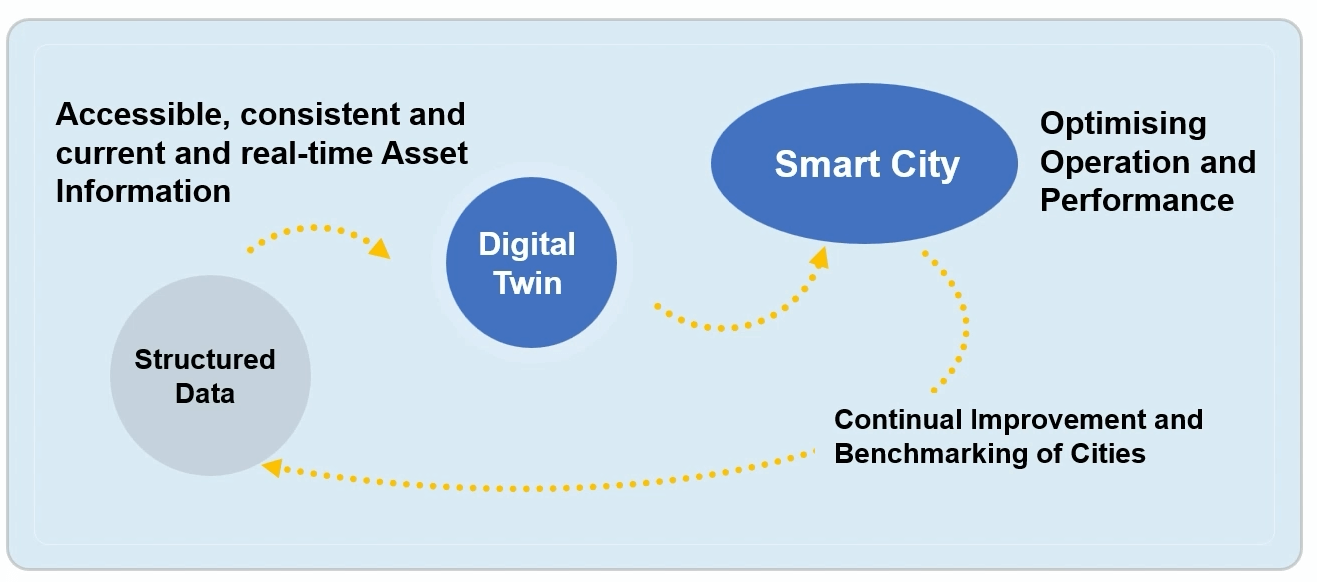Digital Twins Explained: A Guide for the Built Environment
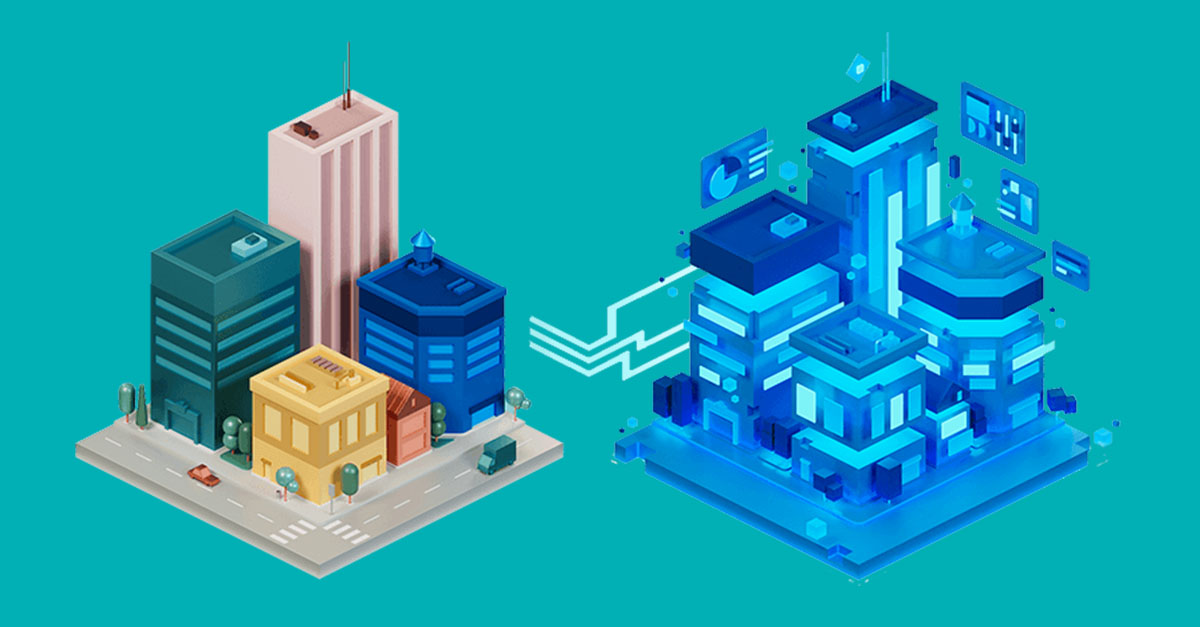
This guide aims to bring some much-needed clarity to digital twins, explaining in simple terms: what they are, why they are important, and when they should (and should not) be used. This guide focuses on the built environment and is intended for stakeholders across all stages of the asset lifecycle. This guide was produced through collaboration with digital twin expert Cristina Savian (Director, BE-WISE).
Chapter 1:
Digital Twins Explained
First you will be introduced to the basics of the digital twins concept, explaining what they are (and are not) in the context of BIM and digital engineering.
State of the Market
“It’s a very confusing market, there’s no other way to explain it.” Cristina Savian (Director, BE-WISE)
When Digital Twins left academia and entered our vocabulary, the concept was met by tremendous enthusiasm and excitement. Before long, eager executives labelled every model a digital twin, enterprising vendors rebranded their products, and overzealous clients requested digital twins without understanding what they needed and why.
Subsequently, the term digital twin has become overused, misstated, and misunderstood. It’s no surprise that today digital twins cause scepticism amongst the cynics.
This confusion was humorously summarised by Nathan Miller in the graphic below.
Source: Nathan Miller @archinate (Nitter)
But are digital twins more than just a buzzword?
This article seeks to explain digital twins and bring some much-needed clarity to the topic, explaining in simple terms what they are, why they are important, and when they should (and should not) be used.
What is a Digital Twin?
Digital twin: a digital representation of a physical asset, process, or system, enriched with data synchronised from the object to inform understanding and decision-making upon its performance.
A digital twin is a virtual model of something that exists in the physical world. It uses the design of a physical object and data synchronised from that object to create a rich information model. This enables stakeholders to visualise the asset, check status, perform analyses and generate insights to predict and optimise asset performance.
A digital twin’s “primary purpose is to use the digital representation to gain valuable insights to improve the delivery, operation and management of a built asset”, Cristina Savian explains.
Digital Twins: The Elephant in the Circus (Cristina Savian)
Video Transcript
Digital Twins: The Elephant in the Circus (Cristina Savian)
Introduction
Connie Butler: Hello and welcome to the second episode in our digital engineering thought leaders series. In this series, we’ll host subject matter experts from the industry to share actionable insights into key topics such as digital engineering, BIM, ISO 19650 and Common Data Environments.
For those of you that don’t know me, my name is Connie Butler and I’m the Digital Engineering Specialist here at 12d Synergy. And for today’s session, I’ll also be your moderator.
This thought leadership series is aimed at all professionals involved in the delivery and operation of built assets. This could include clients and government, asset owners and operators, as well as consultants and contractors.
In this episode, we are extremely pleased to be hosting Cristina Savian. Cristina is the founder of BE-WISE which is an international consultancy focused on driving technology adoption and the construction and property industries. She is a key voice internationally for the adoption of digital twins for built assets. Having authored papers on digital twins with both the Institute of Engineering and Technology (IET) and the Royal Institute of Chartered Surveyors (RICS).
In this session Cristina will give an overview of the digital twin Landscape in ANZ and internationally. She will explain digital twins and the impact on the day-to-day life of the professionals working across the asset lifecycle, as well as sharing some practical insights and lessons learned for their implementation.
If you have any questions for Cristina throughout this presentation, you can submit your questions as shown on the screen. We’ll be hosting a live Q&A session at the end of this, and we hope that Cristina will get to your questions then. Well, that’s enough from me. I’ll hand you over to Cristina
Session Agenda
Cristina Savian: Hi, everyone and welcome to today’s session to discuss one of the most talked about topics in our industry. Yet, what I often like to refer as ‘the elephant in the room’. Let’s talk about digital twins.
This is the agenda for today. I’m going to give you an overview of the digital twin landscape, the impact of digital twins in your day-to-day life. Give you some practical insights into the implementation of digital twins across the design and construction phases and some of the lessons learned from the failures of implementing digital twins.
About the Speaker
But before taking you through this digital twin journey, let’s take a moment to introduce myself. If you’re still wondering where my accent is from I was born and raised in Italy in a town called Turin in the North West of the country.
I started my career qualifying as a building and land surveyor in 1998. I mostly work in civil engineering projects from my local government in my hometown in 2005 and moved to London where I continued my career at Greenwich Council in Transport Operations. After working for the London 2012 Olympics managing the transport operation for Greenwich Park Western Venue, I was head hunted by Autodesk as a geospatial specialist for their civil infrastructure solution for North Europe.
In the last 20 years, I also gained a considerable amount of qualifications including 3 academics degrees in environmental economics, civil engineering and an executive MBA from the University of Cambridge. For the last 4 years, I’ve been running my own company, BE-WISE, management consultancy with offices in London and now Melbourne, Australia. Working with startups and SMEs to help them to bring their technology solution to the construction market. However, digital twins management consultancy services are now my main line of business.
I’m currently recognised as one of the industry experts on this topic. I’m a renowned speaker at industry events around the globe. And we’ll be sharing the biggest conference on this topic in the Southern Hemisphere, the Digital World Build Summit taking place in Sydney on the 23rd and 24th of May. I sit on many industry panels, and in Australia I’m part of the Australasian BIM Advisory Board (ABAB) asset management technical working group. As well as I’ve been lecturing at the University of Melbourne for the last 3 years to undergraduate and postgraduate students enrolled in architecture and construction management courses. Sharing my knowledge and understanding of implementing digital twins for our build assets. My consulting engagement these days span across the world with a lot of work in Europe and especially Middle East. And these are just some of the companies that I’ve been working with for the last 3 years which are not under NDA.
I often like to summarise the digital twin landscape as a circus. And I’m a very passionate and vocal advocate in our industry and one of the many things I do is I run a column on AECbusiness.com, where I write about my experience in this digital twin word. I published an article called ‘The Elephant in the Circus’ at the end of last year which inspired this lecture. So, you might want to have a read.
Digital Twins Explained
So, now let’s start with some basic concepts. I’m sure you’ve researched this topic and you might have Googled the term. Well, I found this image on Twitter last year which I think summarises very well the confusion that there is around this terminology. Let’s be straight forward with this; it’s a very confusing market and there is no other way to explain this. Only a few years ago you can not find some decent publication discussing digital twins and this concept for built assets. And I still remember when I had to start writing the first publication on this topic published by the IET 3 years ago. Now there are hundreds of academic papers, literature and what I like to call a ridiculous amount of nonsense marketing material. To sell you the latest digital twin solution and services. Hopefully at the end of this lecture, you’ve have a bit more clarity on this topic and what it means to you.
For anyone who is new to this digital twin concept, let’s give a bit more history on the terminology. It was Michael Grieves, a professor from the University of Michigan that in 2003 during his course on Product Lifecycle Management, was probably the first person who formally introduced the digital twin terminology. And he described it as a virtual, digital equivalent to a physical product with three main prerequisites. The real space, the virtual space and the connection of data and information that ties the virtual and real space together.
As you can see, it’s a concept that was born in the manufacturing industry and it’s certainly struggling to adapt to the fragmented and very long construction lifestyle. And currently there is no unified definition what a digital twin is for our industry and you will soon realise, it means a lot of different things to a lot of different people depending on where you are at and where you’re working in the asset lifecycle.
The Digital Twin Landscape
Let’s talk about the digital twin landscape. The term is currently used to describe very large amounts of outputs from 3D laser scans, to 3D models, to BIM models to sophisticated Internet of Things (IoT) dashboard to what I like called ‘VR unicorns’ across the entire construction lifecycle. And there is no real set guideline on what should be included or excluded. As mentioned, there is no definition and unified definition these terms and what it means to the AEC world and perhaps who knows, maybe we will never agree on one.
Another interesting fact is that the digital twin term has certainly been leveraged as a marketing strategy and you might have noticed that pretty much overnight everyone is now describing their product and services as a digital twin. It’s multi-million-dollar market, so there is no surprise in that.
One of the facts I noticed is that asset owner buying habits are certainly shifting. New requirements to use the lifecycle approach, digital twin approach according to the ISO 19650 now features in many of the latest standards that I come across. And I’m sure you all know what I’m talking about, because perhaps you watched the previous session in this series by my really good friend Paul Shillcock on ISO 19650. If you haven’t, you might want to go and have a look now.
But also, one of the other interesting things I’ve witnessed is these new requirements to create digital twins for new brownfield assets is really becoming common practice. But unfortunately, there is no specification on what this digital twin should look like, what information should be included or excluded and what business needs this digital twin actually addresses.
So, as I mentioned it’s definitely a very confusing market. Many organisations around the world are trying to bring clarity and make sense of this market. This is just a selection of organisations I follow and they’re very active in this space. From the Centre for Digital Built Britain
(CDBB) in the UK to the Digital twin Consortium in the US and to the very active Smart Cities Council group here in Australia and New Zealand. If you want to know a bit more, the Australasian BIM Advisory Board (ABAB) published a positioning paper early last year, summarising a lot of the work and initiative in this space.
Many governments are now embracing and mandating digital twins as our response to government policies on a diverse range of issues. The UK was probably the first I’ve seen embracing this opportunity with the launch of the Gemini Principles over three years ago. And with the establishment of the Centre for Digital Built Britain and the consequential launch of the National Digital twin Program. With the goal of creating an ecosystem of connected digital twins to ensure a secure, resilient data sharing and effective information management of the entire UK infrastructure network.
In Europe, the European Commission is investing heavily in an EU-wide framework for a digital building logbook. I was part of the initial research and in simple terms it is a database of building related data to encourage data availability and transparency between the various stakeholders across the entire lifecycle.
In the Middle East, digital twins are a very hot topic. I’ve just come back from the Digital Twin Conference in Dubai. And as I mentioned, I work a lot in the region and there are not only cities, but entire countries being built and all the new tenders have digital twins as a requirement for outputs according to ISO 19650.
And here in Australia, you might have heard of the New South Wales Spatial Digital Twin and the Digital Twin for Sydney. But also, of the over $35 million dollars currently being spent to deliver the Digital Twin Victoria. Certainly, very ambitious projects.
The Purpose of Digital Twins
As you have seen, the concept of digital twins has gained significant momentum in recent years and likely it’s not going to stop anytime soon. So, what is the purpose of a digital twin for our built assets? The primary purpose is to use the digital representation to gain viable insights to improve the operation and management of the built asset. In fact, you will find that the majority of the literature addressing this topic is for the benefit of the OPEX. But what does this mean for the early-stage planning, detailed design and construction phases?
Digital Twins from Design to Handover
To shine some light on these early stages, last month we published this white paper with the Royal Institute of Charter Surveyors (RICS) to give you some perspective to professionals and stakeholders working this early phase of the construction lifecycle. If you want a deep dive on this topic, you can use the QR code and download your copy.
In chapter two there are a few graphics and tools that you might find useful. Such as the one representing the functional elements of a Digital twin, the virtual, the physical space as well as the very important synchronisation characteristics in terms of fidelity and frequency.
Another useful resource is what does the system architecture of a digital twin look like, and you can find that too. Not all scenarios and use cases require complex system architecture or whether a master may have seen the reality of implementation and sometimes even very simple use cases end up with very complicated system architecture.
Digital twins are a data driven process and the vast majority of digital data is created, managed and used throughout the asset lifecycle and involves multiple project team members and stakeholders. Exchanging this very large amount and volume of digital data requires the use of a structured information management approach. Well I think you all know what the process is called… [BIM]. And certainly, the building information modelling (BIM) process can definitely come very useful.
So, how does it work? Well, during the design phase we collect a lot of the information that can be put together to create the digital representation of our built asset. So, it should be very simple once the asset is built to create our digital twin, right. Well, it’s not exactly that simple. What is really happening now is that even when the BIM process is followed and the so-called BIM models are created, our digital representation only really includes for the majority only the geometrical elements of the asset. Whereas in order to leverage the digital data across the entire lifecycle and then in the OPEX phase for the purpose of creating this very useful digital twins of our asset, we need rich metadata that can easily be searched, queried and turned into insightful decisions.
What is happening now is a huge breakdown from CAPEX to OPEX. The vast majority of the digital information that is currently being created and collected is during the CAPEX phase. So, there is already a lot of this digital data created, but it’s either missing important elements or is not the right format or structured properly to be used or reused for the purpose of the digital twin.
Why is this happening? Well, many reasons. Some are under our control, some other are difficult to tackle. These are: the legal framework, the industry practice, the lack of interdisciplinary collaboration, no common language and poor interoperability.
In the RICS publication you can find a very useful table (page 17) showing how the data, information, and information management process effectively contribute to developing, deploying, using and updating a digital twin through the use of technology, processes, practices type of data in the context of the various lifecycle stages.
BIM is not a must have for all the digital twins in our built environment, but it is an effective mechanism for creating an accurate and high value virtual representation. So, organisations with strong BIM practices and efficient usage of structured data and reasonably mature information management processes in place, might have an easier time to adopt digital twins.
And lastly, I would like to highlight in chapter 4 (pages 26 & 27), a great table presenting typical scenarios for the application of digital twins from the design to the handover phases based on the type of asset and use case. So certainly not an exhaustive table, but a great starting point to help you to assess if a digital twin is useful or not should you be considering a Digital twin and what’s the purpose? In fact, it is all about the business case and the use case that you are really trying to address.
Digital Twin Challenges
When I get approached to help with the implementation of digital twins, the first thing I ask is ‘why do you want this digital representation of your asset’ and ‘what do you want to do with it?’ And I’m afraid to report that often the answer is ‘I don’t know’, ‘the tender says to’, ‘that’s what my boss wants’, ‘that’s what executive wants.’ But actually, there’s not really been so much thought pointing to asking the question why. So, before you even start you really need to start asking yourself why you want a digital twin, what type of digital twin, the use case you’re trying to address and how you’re going to do it.
Then if you think then the digital twin can provide value which means it will cost less and produce more value than what it costs, then definitely using digital twins can help you answer a lot of your questions you might have.
And to describe this important concept, I would like to use the metaphor of ‘the elephant in the circus’. I like this metaphor, as I said it’s part of my article that you might want to read later on. So our asset data is the elephant in the room, right. Everybody is so uncomfortable to talk about. The circus ring is our construction lifecycle. And as we say during the lifecycle, we exchange a very large amount of data. However, there is just all enough data that can be collected, creatively created and maintained throughout the construction lifecycle sustainably. Producing just enough for what we need and structure it appropriately will underpin the successful creation operations and more efficient use of built assets throughout their lifecycle. I strongly believe that the most challenging and fundamental task that we have to undertake as construction professionals leveraging digital twins for our built asset is keeping the weight off the elephant.
And why this is important? Learning how to keep the weight off the elephant effectively represents the biggest opportunity to digitise and improve the most important industry at the base of our society. As construction professionals, we have the duty of care to leave a more efficient, productive, sustainable environment to future generations. Access to structured data and consistent current and real-time asset information enables us to create digital twins, which enable us to create smart cities and ultimately allow us to optimise operations and performance by continuous benchmarking. So ultimately, we’re not only benefiting by improving the operations of our build asset overall but also, we can enable the virtuous cycle to improve our society overall.
I’m afraid to report that so far, I’ve seen a lot more failures in implementations than successes. And unfortunately, the current trend I’m seeing is not about keeping the weight off the elephant, but actually is creating a digital representation of everything we know about the asset, not just what is needed. Completely missing to take into consideration that there is a massive cost associated with creating and maintaining the digital representation. Digital twins need to provide value.
The term digital twins means a lot of different things depending on where you are in the lifecycle. So, please be mindful on the who, the why and the when. It’s all about the business case and the use cases. The data is only as good as your process and certainly the building information modelling process can help you to streamline the digital information been exchanged. The CAPEX to OPEX hand over means handing over data so it becomes information and not only just the geometry. Because I’m afraid, a lot of the failures I’ve seen is having just a lot of geometry that doesn’t really provide you the extra information that you need to analyse.
Ultimately, the legal framework and procurement model is probably where I’ve seen currently the most amount of points of failure. With a lot of this new digital twin tenders and requirements really asking for something that is just not feasible to deliver and just doesn’t provide value, and ultimately probably costs even more than the built asset itself to create. Whether you are a designer, contractor or operator, I strongly believe that your competitive advantage is your data.
The Opportunity of Digital Twins
To summarise this brief presentation, having access to digital representation of a built asset can provide a huge amount of value. We can’t analyse the physical, but we can certainly can analyse its digital representation. Seeking this insightful information to reduce operating costs, optimise performance and sustainability, reduce rework, and improve communications which ultimately on a macro level translates into a better society, economy and environment.
Thank you for listening. You can find me on LinkedIn, on Twitter and on my website where you can find a lot of resources on Digital twins. Now let’s answer your questions. Thank you for listening.
Outro
Connie Butler: Thank you so much Cristina. I certainly found your presentation insightful and it was an excellent overview of the digital twins landscape.
As Cristina mentioned, one of the key aspects of digital twins is the efficient and effective information management through ISO 19650. If you’d like to learn more about ISO 19650, our team has put together a guide on the series that distills the key concepts and principles of the standard throughout information management process.
Well, that’s it from us on this episode. If you want to catch up on anything you’ve missed today, I’ll be sharing the recording of this webinar with you shortly. You can also catch up with previous sessions on this series on the 12d Synergy website.
Lastly, I want to reach out and call all thought leaders. If you or a colleague have an innovative topic to share, we’d love to hear from you. So please get in touch through our email info@12dsynergy.com.
Thank you once again for joining us today. Stay tuned for more episodes in our Digital Engineering Thought Leaders series.
Digital Twin’s Difficulties Adapting to the Built Environment
The digital twin was conceptualised in 2003 by Dr Michael Grieves for manufacturing, and later practically applied by NASA in 2010 to improve their simulations of spacecraft.
This early concept of digital twins consisted of three components:
- The physical product
- The virtual product
- Connections between the two products
These connections being bi-directional: data synchronised from the physical to the virtual, and decisions made from the virtual implemented upon the physical.
An Early Digital Twin Concept by Grieves and Vickers. Source: Wikipedia
While these three components remain, the digital twin concept has nonetheless “struggled to adapt from manufacturing to the long and fragmented built asset lifecycle.” Digital twin is a loose concept broadly used across many industries, including aerospace, defence, health, manufacturing, logistics, facilities, and the built environment. “Digital twins mean a lot of different things to different people… there’s currently no unified definition of what a digital twin is for our industry”, Cristina Savian explains
Digital Twins Explained PDF
Download this full article as a PDF, including digital twins overview, why and when to use them, and lessons learnt.
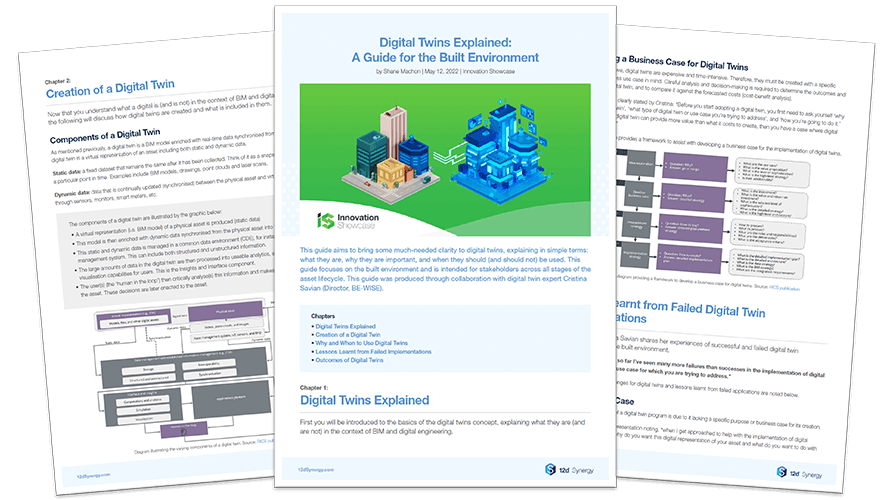
Digital Twins and BIM Models
Right now, you might be thinking ‘this is all sounding very familiar. How are digital twins different to BIM models?’
You’d be right to think this. Digital twins are not a revolutionary phenomenon, but rather a continuation of the industry’s pre-existing trend towards digitalisation, from hand-drawn drafts to CAD drawings, to 3D BIM models, and now, to digital twins.
What distinguishes a digital twin from its BIM counterpart is the connection to the physical asset. A digital twin is enriched with data captured from the asset and synchronised to the virtual representation, while a BIM model is generally lacking this connection of real-time data.
Source: Digital twins from design to handover of constructed assets, published by the Royal Institute of Chartered Surveyors (RICS). Read the publication here.
A BIM model is converted into a digital twin by enriching the model with static and real-time data synchronised from the asset. This data is captured from the asset through technologies including sensors, monitors, and smart meters.
Therefore, a digital representation without this connection of synchronised data from the physical asset is simply a model, not a digital twin.
Digital Twin in Context
Digital twins are not an isolated concept but exist within the greater context of other industry processes, practices, and concepts. This concept is illustrated well in the graphic below. Digital twins encapsulate BIM and as-built models, and are produced using digital engineering processes. Together, digital twins can coordinate information through an integrated platform to help deliver smart cities and smart infrastructure.
Source: Digital twins from design to handover of constructed assets, published by the Royal Institute of Chartered Surveyors (RICS). Read the publication here.
Chapter 2:
Creation of a Digital Twin
Now that you understand what a digital is (and is not) in the context of BIM and digital engineering, the following will discuss how digital twins are created and what is included in them.
Components of a Digital Twin
As mentioned previously, a digital twin is a BIM model enriched with real-time data synchronised from the asset. The digital twin is a virtual representation of an asset including both static and dynamic data.
- Static data: a fixed dataset that remains the same after it has been collected. Think of it as a snapshot of the project at a particular point in time. Examples include BIM models, drawings, point clouds and laser scans.
- Dynamic data: data that is continually updated (synchronised) between the physical asset and virtual representation through sensors, monitors, smart meters, etc.
The components of a digital twin are illustrated by the graphic below:
- A virtual representation (i.e. BIM model) of a physical asset is produced (static data)
- This model is then enriched with dynamic data synchronised from the physical asset into the digital twin
- This static and dynamic data is managed in a common data environment (CDE), for instance a data management system. This can include both structured and unstructured information.
- The large amounts of data in the digital twin are then processed into useable analytics, simulation, and visualisation capabilities for users. This is the Insights and Interface component.
- The user(s) (the ‘human in the loop’) then critically analyse(s) this information and makes decisions upon the asset. These decisions are later enacted to the asset.
Diagram illustrating the varying components of a digital twin. Source: RICS publication
Digital Twins Explained PDF
Download this full article as a PDF, including digital twins overview, why and when to use them, and lessons learnt.

Information Management for Digital Twins
Digital twins can contain vast volumes of data and information, from 3D models and drawings, to point clouds and as-builts, to real-time asset performance data.
Data and information management are key drivers to the effective development, deployment, and use of digital twins in the built environment. Like BIM, the success of a digital twin application is dependent upon the information management processes adopted by the implementation team.
“Digital twins are a data-driven process, requiring multiple team members and stakeholders throughout the asset lifecycle exchanging very large amounts and volumes of digital data. This requires the use of a structured information management approach”, explains Cristina.
The Centre for Digital Built Britain (CDBB) in this publication defines information management as a “formal mechanism to ensure that the right information can be made available at the right time, to the right people and that quality of the information is known and understood.”
Cristina recommends in her presentation that, “in the RICS publication you can find a very useful table showing how the data and information management process effectively contribute to developing, deploying, using and updating a digital twin. Achieved using technology, processes, practices, type of data and in the context of the various asset lifecycle stages”. This table is illustrated below.
Diagram showing data, information and information management activities across the asset lifecycle in relation to digital twins. Source: RICS publication
Cristina explains that “BIM is not a must have for all the digital twins in our built environment. But it is an effective mechanism for creating an accurate and high-volume virtual representation. An organisation with strong BIM practices, efficient usage of structured data and reasonably mature information management processes in place will have an easier time adopting digital twins.”
Digital Twins and ISO 19650
ISO 19650 is an international framework for information management often utilising BIM in the built environment. The overall objective of the ISO 19650 series is to make the right information available to the right people at the right time so they can make the right decisions. This objective works hand in hand with the guiding purpose of digital twins.
Presently, requirements and tenders for the delivery of digital twins, may specify the information requirements of ISO 19650 to be followed.
For more information on ISO 19650 we recommend reading our Ultimate Guide to ISO 19650, which provides a comprehensive overview of the series and how it impacts the built environment.
Chapter 3:
Why and When to Use Digital Twins
This next section will discuss the benefits of digital twins for the built environment and when they should (and shouldn’t) be adopted.
The Benefits of Digital Twins
Cristina explained that having access to a digital representation with synchronised real-time information of a built asset can provide a huge amount of value, including:
- Improved visualisation of the project and communication of design intent
- Enhanced decision-making and project execution through greater information accessibility
- Increased productivity and improved multi-disciplinary collaboration
- Reduced rework, construction, and operating costs
- Improved safety
- Optimised asset performance and sustainability
- Improved quality
- Revenue growth opportunities
Despite the numerous benefits, it is notable that digital twins are time and cost intensive to produce, use and manage.
Use Cases for Digital Twins
Due to the costs associated with digital twins, to derive value a business case must clearly specify why it is needed and how it will be used. A digital twin must serve a specific purpose for the built asset.
Cristina notes, “one of the interesting things I’ve witnessed is new requirements to create digital twins for new brownfield assets is really becoming common practice. But unfortunately, there is no specification on what this digital twin should look like, what information should be included or excluded and what business needs this digital twin actually addresses.”
Digital twins can be utilised throughout the asset lifecycle, during design, construction, handover and the operation and maintenance (O&M) stages. However, digital twins may not be suitable for all built assets or projects.
Below is a helpful table from the RICS publication which outlines some typical scenarios when digital twins should and should not be used, across various lifecycle stages and asset types.
A table explaining the use cases for digital twins across asset type and lifecycle stage. Source: RICS publication
Developing a Business Case for Digital Twins
As mentioned above, digital twins are expensive and time-intensive. Therefore, they must be created with a specific purpose or business use case in mind. Careful analysis and decision-making is required to determine the outcomes and benefits of the digital twin, and to compare it against the forecasted costs (cost-benefit analysis).
The argument was clearly stated by Cristina: “Before you start adopting a digital twin, you first need to ask yourself ‘why you want a digital twin’, ‘what type of digital twin or use case you’re trying to address’, and ‘how you’re going to do it.’ Then if you think a digital twin can provide more value than what it costs to create, then you have a case where digital twins can help you.”
The RICS publication provides a framework to assist with developing a business case for the implementation of digital twins.
A flow chart diagram providing a framework to develop a business case for digital twins. Source: RICS publication
Chapter 4:
Lessons Learnt from Failed Digital Twin Implementations
In this chapter, Cristina Savian shares her experiences of successful and failed digital twin implementations for the built environment.
“I’m afraid to report that so far I’ve seen many more failures than successes in the implementation of digital twins… It’s all about the use case for which you are trying to address.”
Some of the common challenges for digital twins and lessons learnt from failed applications are noted below.
No Defined Use Case
A common reason for failure of a digital twin program is due to it lacking a specific purpose or business case for its creation.
Cristina reiterates this in her presentation noting, “when I get approached to help with the implementation of digital twins, the first thing I ask is ‘why do you want this digital representation of your asset and what do you want to do with it?’ And I’m afraid the answer more often than not is ‘I don’t know’, ‘the tender says so’, ‘that’s what my boss wants’. But actually, there hasn’t been much thought into asking the question why.”
Too Much Data
Another common reason for failure, is not prioritising what data should be collected in line with the digital twin’s purpose.
Cristina notes, “unfortunately, the current trend I’m seeing is not about minimising the data collected, but actually is creating a digital representation of everything we know about the asset, not just what is needed. Completely missing to take into consideration that there is a massive cost with creating and maintaining a digital twin. Digital twins need to provide value through meeting a specific purpose.”
“There’s so many different types of data, from 3D laser scans to 3D models, sophisticated IoT dashboards, and there are no set guidelines on what data should be included or excluded, or what business needs are to be addressed.”
The solution here is to clearly define the ‘why’ (purpose), the ‘what’ (data) and the ‘how’ (process) of the digital twin, and then to only collect and model data that meets the specific purpose. Just because you can collect something, doesn’t mean you need to or that it will add value.
Breakdown Between Delivery & Operational Phases
Another common point of failure Cristina identified is the breakdown between delivery (CAPEX) and operational (OPEX) phases, wherein the handover of data does not provide sufficient granularity to create a digital twin.
“During the design phase a lot of information is collected and put together to create the digital representation of our built asset (i.e., the BIM model). So once the asset is built, it should be very simple to create our digital twin, right? Not exactly.”
“What is happening now, when the BIM process is followed and BIM models are created, our digital representation generally only really includes the geometrical elements of the asset. Whereas, to leverage the digital data across the entire lifecycle and into the OPEX phase our asset needs rich meta-data that can be easily searched, queried, and turned into insightful decision making.”
“There’s a huge breakdown from CAPEX to OPEX. The value of digital information is currently created and collected during the CAPEX phase. There is already a lot of this digital data but it’s either missing important elements or is not the right format or structure to properly be used or reused for the purpose of creating the digital twin.”
Reasons for these Challenges
In her presentation, Cristina suggests that the reason for these challenges is predominately due to:
- The legal framework
- Industry practice
- Lack of interdisciplinary collaboration
- No common language
- Poor interoperability
“The legal framework and procurement model is probably the most challenging point of failure. Digital twin tenders and requirements asking for something that is simply not feasible to deliver, doesn’t provide value, and in some cases costs more to produce than the physical asset itself… digital twin tenders are looking for unicorns.”
Chapter 5:
Outcomes of Digital Twins
Creating a digital representation with synchronised real-time information of a built asset can provide significant value to all types of built assets throughout the asset lifecycle. Cristina however further explains that digital twins can also improve society overall.
“Learning how to effectively create digital twins represents the biggest opportunity to digitise and improve the most important industry at the base of our society. As engineering and construction professionals we have a duty of care to leave a more productive, efficient, and sustainable built environment for future generations. Access to structured, consistent and real-time data and asset information enables us to create digital twins. This in turn enables us to create smart cities and to optimise the operation and performance of our cities through continuous improvement and benchmarking. So ultimately, we’re not only improving the operation of our built asset, but we’re also enable the virtuous cycle to improve our society overall.” This virtuous cycle is illustrated below.
Source: Cristina Savian, The Elephant in the Circus: Let’s talk about Digital Twins presentation (watch here)
Conclusion
The term ‘digital twin’ has become overused, misstated, and misunderstood. The concept born in the manufacturing industry has struggled to adapt to the built environment. This article aimed to bring clarity to the concept.
A digital twin is a digital representation of a physical asset, process, or system, enriched with data synchronised from the object to inform understanding and decision-making upon its performance.
Digital twin is not a new phenomenon, but the continuation of the industry’s pre-existing trend towards digitalisation, and exists within the greater context of digital engineering, BIM, and as-built models.
Nonetheless digital twins present a substantial opportunity to digitise our built assets and provide beneficial and profitable outcomes to stakeholders across the asset lifecycle. However, due to the substantial time and costs associated with their creation, management and use, digital twins should only be implemented where a specific business case and cost-benefit analysis allows.
We welcome your thoughts and feedback. Get in touch with the author on info@12dsynergy.com.
Resources
Below is a list of recommended resources for learning further about digital twins for the built environment.
- Digital twins from design to handover of constructed assets (Royal Institute of Chartered Surveyors (RICS))
- Digital Twins, An ABAB Position Paper (Australian BIM Advisory Board (ABAB))
- Making the business case for a Digital twin toolkit (CDBB)
- Digital Twins for the built environment report (IET)
- The Ultimate Guide to ISO 19650 (12d Synergy)
Digital Twins Explained PDF
Complete the form below to download this full article as a PDF, including digital twins overview, why and when to use them, and lessons learnt.


